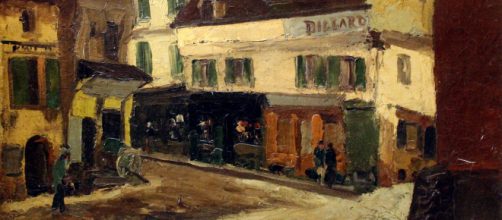You might tag this story the honor of thieves, but it’s more than robbers doing the right thing. It’s taking action outside of accepted norms to correct a wrong.
Behold, a German museum that goes one better than returning Nazi-looted artworks to their Jewish owners by offering to buy it back.
This week, Berlin’s Old National Gallery, The Alte Nationalgalerie, bought back a prized Camille Pissarro painting that entered its collection through the Third Reich. The French Impressionist’s picture titled "A square in La Roche-Guyon" was owned by Armand Doryville, a German-Jewish lawyer until he was forced to “sell” it to the Nazis.
Prize purchase
Only last month, Doryville’s heirs, residents of France, had traveled to Berlin to ask for the return of the Pissarro painting. Alte Nationalgalerie did not refuse, as is the usual response to Jewish claims for Nazi-looted art. Instead, this National Gallery handed over the painting and then paid an undisclosed sum to hang it again on the museum’s exhibit wall.
In a statement, Museum director Ralph Gleis explained that Pissarro’s picture is “of great importance” for the collection because it shows the start of the artist’s move to Impressionism – the institution’s “core holding.”
To appreciate how big this news is, consider the typical response in restitution cases dramatized in the 2015 movie “Woman In Gold” starring Dame Helen Mirren.
The script was based on a true story of an elderly Jewish refugee living in LA – Maria Altman – who battled the Austrian government for nearly ten years to reclaim the portrait of her aunt, Adele Bloch-Bauer, by Gustave Klimt.
Command decision
The Nazis stole the painting from Altman’s family when they lived in Vienna. After repeated rejections from the Austrian government, she took her plea to the U.S. Supreme Court (Republic of Austria v. Altman) and won the case. The court ruling was based on the Foreign Sovereign Immunities Act of 2004, which applies retroactively.
The Pissarro painting was a likely part of the Nazi heist recounted in the movie “The Monuments Men” and the 1,400 artworks carted on trains bound for Berlin.
The artist was a Jew who his fellow Impressionists Degas and Renoir refused to greet when they met him on the street.
Anti-semitism in the ranks
Stephanie Rachum, writing in her 2016 book “Camille Pissarro’s Jewish Identity,” said that when the artist died, Degas wrote this to a friend: “What went on inside that old Israelite head of his? Did he think only of going back to the old times when we were pretty nearly unaware of his terrible race?”
Given the importance of Pissarro’s painting to the Alte Nationalgalerie and all the art lovers who visit it, Doryville’s heirs agreed to sell it. Grateful for their willingness, the president of the Prussian Cultural Foundation, Hermann Parzinger, said, “We will continue to work with all our might…not to let the injustice that happened be forgotten.”
In context
Another way to appreciate the import of this story is a report on Oct.
24 in J-Wire, digital Jewish news daily for Australia and New Zealand, noting more than 2,000 anti-Semitism incidents in Germany last year and nearly the same number the year before.
Germany has a tragic history, both past, and present when it comes to the Jewish people. And while doing the right thing shouldn’t warrant praise, in the divisive world in which we live, I heap high praise on the Alte Nationalgalerie.


